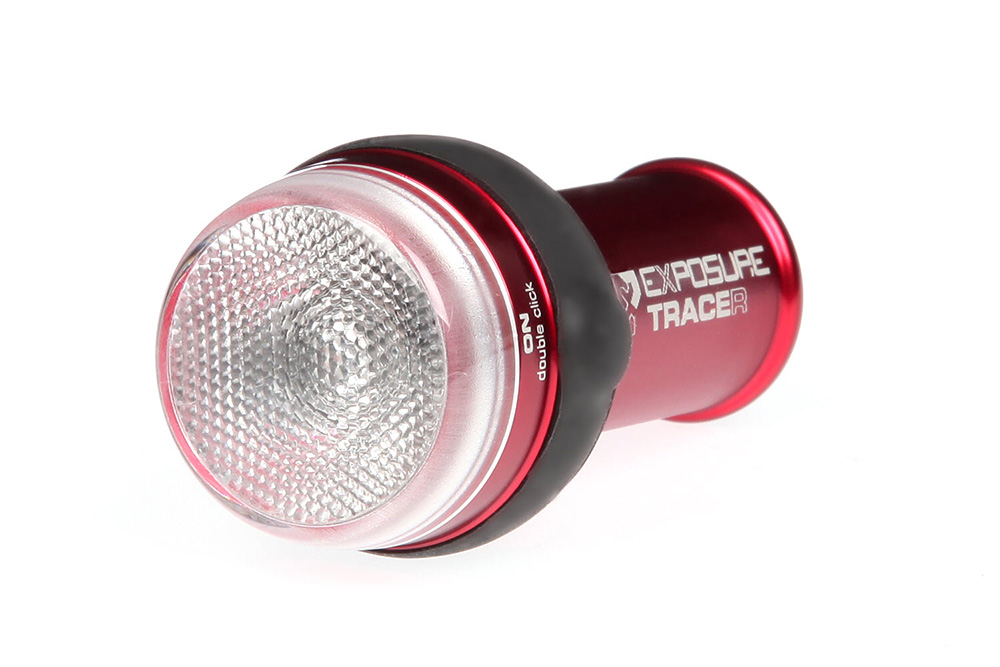Exposure TraceR rear light review
British brand Exposure provide well built, stylish and bright lights for both road and off-road riders. The Exposure TraceR has done a great job at keeping me seen from the rear

At £52.45 for a single light is a tad expensive but this light has been an amazing commuting companion throughout the winter. I can leave it on for over a week without charge worry and I'm confident I'll be seen with the decent 75 lumen output.
-
+
Bright
-
+
Compact
-
+
Good battery life
-
-
Rubber band round charge point fiddly
-
-
Pricey
You can trust Cycling Weekly.
Exposure is a British brand that prides itself on making quality British built products that will last the hard riding conditions in the UK. The Exposure TraceR rear light follows that mantra and excels as a rear light especially for the commute.
>>> Buy now: Exposure TraceR from Wiggle for £49.95
Ok, so it is a little pricey for a single unit, though you can opt for the non-rechargeable (replaceable battery) Flare at £36.70, which produces the same 75 lumens, but lose the DayBright pulse pattern and a few hours of burn time.
>>> buy now: Exposure Flare from Wiggle for £26.21
Easy and secure clip in and out bracket, which is also easy to remove from the seatpost due to its rubber mounting. It also fits aero posts and is angled so you can have it set at the right height, so it doesn't blind other riders or drivers but equally isn't wasted pointing at the ground.
The Exposure TraceR has three programmes to cycle through, you choose by holding the on button, which will flash three times, you let the button go after each flash to choose between the programmes - each program has one constant and one pulse mode. First flash is the highest output setting with a burn time of three hour constant, six hour on pulse. Second six and 12 hours and finally the third program has a constant of 12 hours and pulse of 24 hours.
You'll need to double press to turn on.
When you switch the Exposure TraceR off, it'll indicate battery life with a green or red light a handy touch to indicate if you need charge or not.
USB rechargeable that'll take three hours from empty to fully charge and is accessed by pulling the rubber tab that joins the on and off button. It is a little fiddly and I worry over time this could snap (including the bracket band) but ultimately if it did, this would be easily replaceable.
The Exposure TraceR has just been easy to use, I've not worried about its build quality, which is excellent by the way. Its compact, lightweight, smart looking and provides everything you need to remain see from the rear at night and in the day time.
Yes, as I've mentioned early on, the Exposure TraceR price is high but with two years warranty and a high quality light, with the confidence of being seen, it is worth the price tag.

Thank you for reading 20 articles this month* Join now for unlimited access
Enjoy your first month for just £1 / $1 / €1
*Read 5 free articles per month without a subscription

Join now for unlimited access
Try first month for just £1 / $1 / €1
Get The Leadout Newsletter
The latest race content, interviews, features, reviews and expert buying guides, direct to your inbox!
Symon Lewis joined Cycling Weekly as an Editorial Assistant in 2010, he went on to become a Tech Writer in 2014 before being promoted to Tech Editor in 2015 before taking on a role managing Video and Tech in 2019. Lewis discovered cycling via Herne Hill Velodrome, where he was renowned for his prolific performances, and spent two years as a coach at the South London velodrome.
-
 A bike rack with an app? Wahoo’s latest, and a hub silencer – Sea Otter Classic tech highlights, Part 2
A bike rack with an app? Wahoo’s latest, and a hub silencer – Sea Otter Classic tech highlights, Part 2A few standout pieces of gear from North America's biggest bike gathering
By Anne-Marije Rook Published
-
 Cycling's riders need more protection from mindless 'fans' at races to avoid another Mathieu van der Poel Paris-Roubaix bottle incident
Cycling's riders need more protection from mindless 'fans' at races to avoid another Mathieu van der Poel Paris-Roubaix bottle incidentCycling's authorities must do everything within their power to prevent spectators from assaulting riders
By Tom Thewlis Published
-
 Man hands himself in to Belgian police after throwing full water bottle at Mathieu van der Poel during Paris-Roubaix
Man hands himself in to Belgian police after throwing full water bottle at Mathieu van der Poel during Paris-Roubaix30-year-old was on Templeuve-en-Pévèle cobbled sector when television pictures showed the bottle hitting him in the face
By Tom Thewlis Published